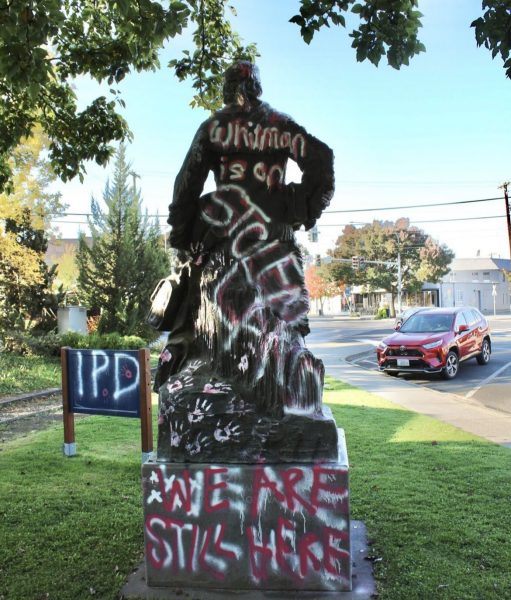The vandalism of the Marcus Whitman statue on Oct. 14 joins a list of several actions amidst controversies surrounding this particular statue. In 1953, the first Marcus Whitman statue was installed in the U.S. Capitol, and another was installed on the front steps of the State Capitol in Olympia. In 1992, a third statue was placed in Walla Walla on the border between the city’s downtown and Whitman College.

In May 2021, Gov. Jay Inslee passed legislation to remove the Whitman statue in D.C. According to the Northwest Treaty tribes, Marcus Whitman’s statue was chosen to be removed because it had been there the longest of the state’s two statues. Whitman’s statue will be relocated to an appropriate location in Walla Walla County when it returns to Washington State.
On the Whitman campus, there has been a growing call for the removal of the Marcus Whitman statue. Several activities, including student and faculty debates, protests, and repeated vandalism of the statue—with the latest incident occurring on Oct. 14—have taken place. In a statement to The Wire, Jeanine Gordon, Special Assistant to the President for Native American Outreach, shared her response.
“In response to vandalism of the Marcus Whitman statue and vandalism in general, as an American Indian, I consider myself to be a steward. As I grew up in my tribal community, we were taught to be stewards. Stewards of one another, of our livelihood, of our community, of our animals, of our plants, of our land, of our water, and ultimately of this earth upon which we live,” Gordon said.
Following the spray-painting of the Marcus Whitman statue in the spring of 2018, Whitman College, through their first-year seminar, then known as Encounters, decided that a unit on the impact of Marcus Whitman would create productive discourse among the first-year students.
In an interview with The Wire, Libby Miller, Senior Adjunct Assistant Professor of Art History and General Studies, and Director of the Maxey Museum of Northwest History, narrated how the exhibition, “A Proper Monument?”, became part of the Encounters program syllabus. Miller mentioned that the goal of putting the exhibition on the Encounters syllabus was twofold. Miller believes in the importance of teaching Whitman’s story because it has to do with the college’s complex history and professors were interested in helping students think through that. Despite the exhibit only being taught for two semesters, Miller believes it made an impact.
Miller also stated that although the statue is no longer on the first-year-seminar syllabus, she and some of her colleagues in art history continue to teach about the statue.
Whitman Teaches The Movement (WTTM) and Indigenous People’s Education and Culture Club (IPECC) held a protest on Apr. 23, 2021, to finally remove the Marcus Whitman statue from campus. Later in October 2021, Whitman’s history department and the Confederated Tribes of the Umatilla Indian Reservation (CTUIR) co-sponsored a series of events titled “Unmaking Whitman, Unlearning the Myth.” The series featured three days with guest speakers, Whitman faculty, and community members of the CTUIR who critically examined the legacy of Marcus Whitman.
Miller supervised two students who were the leaders of IPECC at the time in writing a proposal to re-contextualize the Marcus Whitman statue. The proposal was presented to the Walla Walla Arts Commission to talk about and present a case for removing the statue in 2020. According to Miller, those conversations died out at the level of the City Council. Miller affirms that the ideal thing would be to remove the statue, but she also questions whether it can be re-contextualized by having informative text put near it.
Gordon expressed her sentiments over the recent vandalism of the statue, acknowledging the possible reasons behind it.
“I was saddened by the vandalism, even though I understood the underlying emotion. I was saddened because the sign next to the Marcus Whitman statue was and is something I was very proud of as a visual statement of the work we are doing here at the college through the Memorandum of Agreement with the Confederated Tribes of the Umatilla Indian Reservation, through the Šináata Scholarship and through my role as Special Assistant to the President for Native American Outreach and the amazing and progressive programming we have built in the last year and a half—and that we will continue to build. I celebrated the sign that others felt the need to vandalize,” Gordon said.
The recent vandalism of the Marcus Whitman statue reflects ongoing discourse and tensions around its presence and the legacy of Marcus Whitman, reflecting the complexity of historical legacies and the need for progressive conversations.




